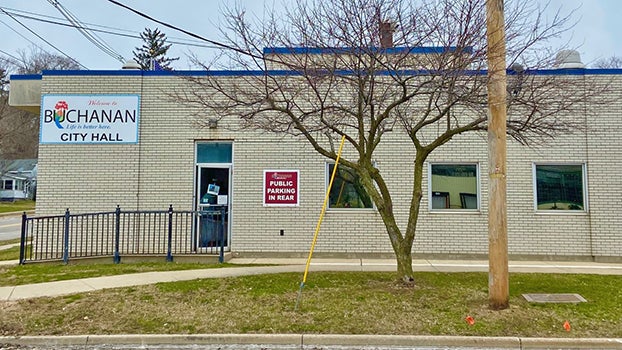Lazy Susan for cattle
Published 8:52 am Wednesday, August 19, 2009

It took Keith Russom about four years of trial and error to work all the bugs out of his masterpiece. The first Roto-Feeder was perfected 53 years ago in 1956. (The Daily News/Provided)
By RYAN RUSSOM
Special to Daily News
A zapping sound from John Russom’s welder arcing the metal, followed by a loud BOOM from a hard strike of his hammer that echoes right out the door, can be heard when pulling up to historical Roto-Feeders Inc. in Dowagiac.
A red spark of metal being bonded together glows throughout the dark shop along with a thick cloud of blue smoke lingering overhead creating fumes of burning metal.
Sunlight beams through the openings in the rotted roof. Water is puddled on the concrete floor and barn swallows fly in and out of the windows where no glass is present.
John is bent over a huge sheet metal ring engulfed in smoke as an intense blue light flashes when the rod makes contact with the steel.
No welding mask is worn for protection as sweat heavily beads off his unveiled face, and his eyes are bloodshot red.
A handful of foot-long welding rods stick out of the back pocket of his dark, holey blue jeans with plaid flannel tucked inside.
Heavy brown leather gloves shield his hands and black work boots protect his feet.
“A push of a button can now fill the stomachs of livestock,” Keith Russom proclaimed about his Roto-Feeder, which became a tremendous development in its technological age of agriculture.
This metal fabricated device rotates feeding grain smoothly around the base of a silage feeder, driven by a fractional horse power motor, to feed cattle efficiently.
The trough is 29 inches wide and 10 inches deep, which holds a generous amount of silage or green chop.
It’s a heavy-gauge welded steel construction, treated with rust inhibitor primer and green epoxy finish coat paint that involves approximately 20 hours labor and can be seen on dairy farms across America.
It has a simple, sturdy design with an average lifespan of 15 years that guarantees years of trouble-free service, as well as a low-maintenance product.
Keith Russom, founder of “power feeding,” was a local dairy farmer who loved working with his hands, up milking cows and farming at the break of daylight and then working on his dream in the late-night hours.
He won the award for high herd in the Cass County Dairy Herd Improvement Association year after year in the 1950s.
One year he had a record 34 registered-grade Holsteins on his farm.
Keith was well-known in his Dowagiac community, constructing Russom Little League baseball fields in 1968 and donating it to the City of Dowagiac, allowing young boys, and now girls, the opportunity to play baseball and softball locally for more than four decades.
“It took Keith about four long years of trial and error to work all the bugs out of his masterpiece and allow for his dream to come true,” says John Russom, second generation and current owner, before the product was first perfected 53 years ago in 1956, while in the process of welding his father Keith Russom’s invention, The Roto-Feeder.
Keith referred to his advancement as “lazy Susans for cattle,” and said, “It’s a substitution of mind and mechanics for human muscle.” He also mentioned how “it took a lot of the backbreaking out of mixing and feeding grain or pitching silage to hungry cattle.”
“He wanted to design an efficient, low-maintenance way for cattle to graze, therefore, he came up with the idea of a lazy Susan silage feeder, which allows the cows to become more compacted and economical feeding a larger quantity,” John explains.
John Russom is Keith’s oldest son. He graduated from Union High School in the Class of 1975 and has been a Dowagiac resident for more than 50 years.
He’s a skilled welder and fabricator with more than 35 years experience working in the family business.
Currently, he runs Roto-Feeders Inc. alongside his younger brother, Thomas Russom.
Tom’s also a DUHS graduate who has lived in the community for more than 50 years.
The very first lazy Susan feeder that Keith designed was intended for his own personal use originally, but as his brilliance began to be recognized by the diary farming world, it became a must for their farm as well.
His Susan feeders became so popular with dairy farmers in the Midwest that his associates had a hard time keeping up with the high demand.
In October 1958, Hoard’s Dairyman – The National Dairy Farm Magazine, granted him permission to put a photo of the Roto-Feeder on the front cover of their magazine.
“It was a thriving business back in the ’60s that made a half to three quarters of a million dollars a year in revenue, which is damn good money – especially in those days,” confirms Tom Russom, Keith’s other son and employee at Roto-Feeders. “We would put out 150 plus feeders a year back then with about eight employees. We’ve even sent one to Europe and a few to Canada, also.”
“My husband (Levi) was very pleased with the Roto-Feeder,” Myrna Van Tuyle confesses about the product from Van Tuyle Farms in Dowagiac. “He bought three of them over the last 30 years of his farming days.”
The product even became a hit with young children.
“A guy used to take one to the fair and kids would ride on it like it was a carousel,” says John. “That was a real sight to see.”
Roto-Feeder has been on a drastic downslide over the last decade, as dairy farmers have phased out silage feeding in favor of a supplemental feeding system without using grain.
“Now, my brother Tom and I only build around 18 units a year,” John explains. “The business relied heavily on the smaller dairy farms. Most have been bought out by larger ones. We still build replacement feeders for the ones that have rusted out over the years and need replacing.”
Although now the existence of the business may be in jeopardy as demand declines, it has stood for 50 years of outstanding quality along with satisfied repeat customers, and two sons to keep their father’s dream alive.
Editor’s note: Ryan Russom, a 1995 Dowagiac Union High School graduate and electronics major, wrote this article for his English 103 class at Southwestern Michigan College taught by Sarah Smith.
We thought the history of Roto-Feeders would be of particular interest to our readers given the Russom family’s contribution to development of the Little League fields at Middle Crossing Road and Yaw Street with Silver Creek Township into a youth sports complex.
Ryan is the son of John and Kathy Russom and the grandson of the late Keith and Betty Russom.






